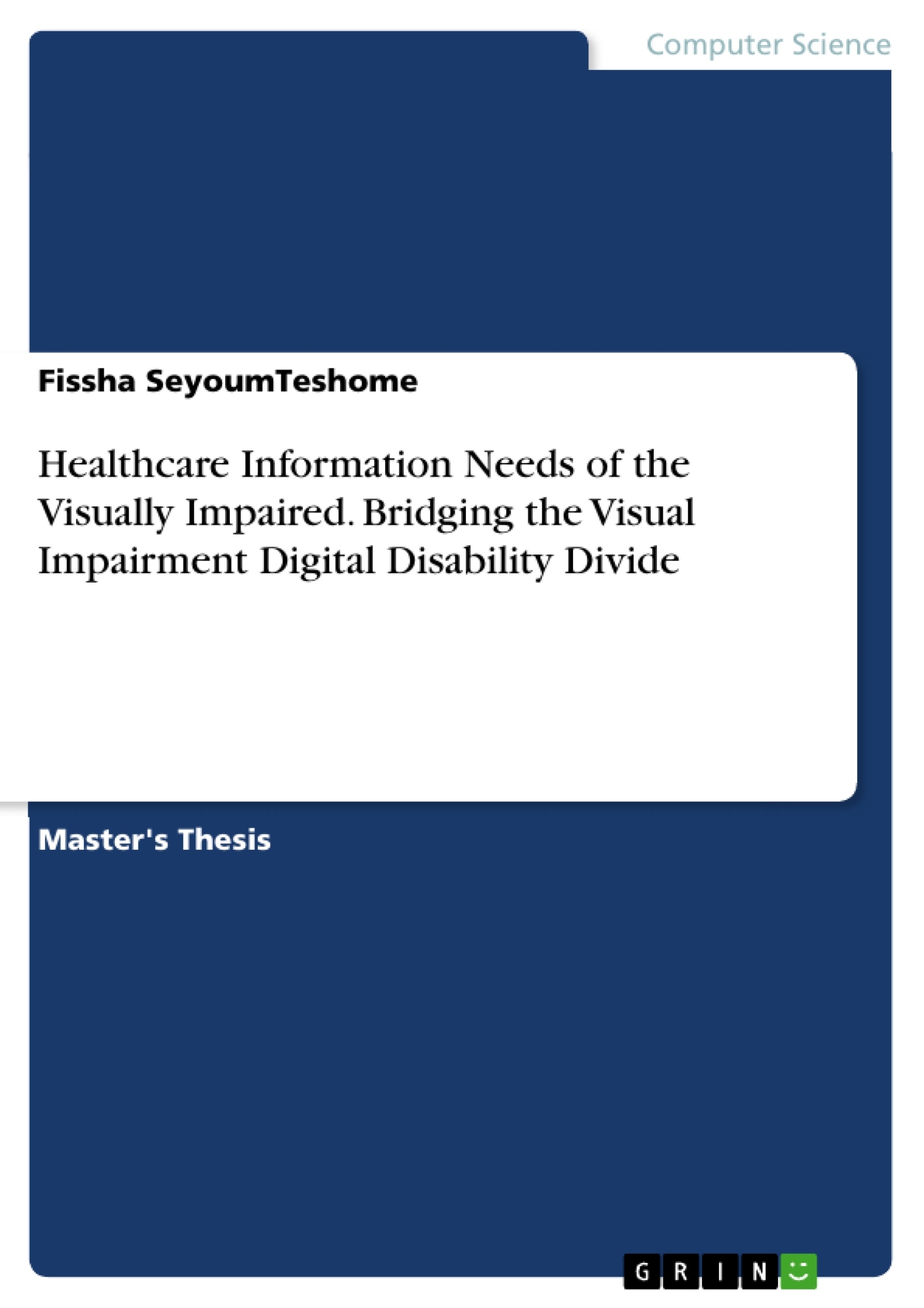The focus of this research is to develop an understanding of how visually impaired people face a digital disability divide. The scope of this research is limited to people with visual impairments who may or may not have access to technology. The research shows how to bridge the divide while exploring relevant topics that lead to the conception of feasible solutions. Further, it will contribute to the development of more socially inclusive healthcare information systems.
The research is supported by a thorough literature review of articles, journals, and research reports dealing with the major relevant topics.
A qualitative research method was used to identify and obtain an in-depth understanding of the healthcare information accessibility (HCIA) barriers that visually impaired people face, and the factors involved in the creation of these barriers. Moreover, a quantitative method was used to collect primary data, and a number of different analysis methods were used to produce results. This led to findings that were generalized to the larger population of the visually impaired.
The research shows that, despite the staggering advances in information and communication technology (ICT), the healthcare information needs of the visually impaired are not being met. However, it has also been discovered that the digital divide caused by visual impairment can be mitigated with intelligent design and the realization of information systems intended to fulfill the healthcare information needs of the visually impaired. A logical information system is needed that has a combination of input, back-end, and output assistive technologies with increased social inclusion and the capability to empower visually impaired people and help them access available healthcare information.
Inhaltsverzeichnis (Table of Contents)
- INTRODUCTION
- RESEARCH BACKGROUND AND MOTIVATION
- RESEARCH FOCUS AND SCOPE
- RESEARCH PURPOSE AND GOALS
- RESEARCH STRUCTURE
- HEALTHCARE INFORMATION ACCESS
- TYPES OF BARRIERS
- AWARENESS BARRIERS
- PATIENTS' PRESUMPTION
- PROVIDERS' STANCE
- EXECUTIVES' APATHY
- MANUFACTURERS' EXCLUSIVENESS
- ACCESSIBILITY BARRIERS
- MOTIVATIONAL BARRIERS
- HEALTHCARE INFORMATION NEEDS OF THE VISUALLY IMPAIRED
- VISUAL IMPAIRMENT AND THE DIGITAL DIVIDE
- ASSISTIVE TECHNOLOGIES FOR THE VISUALLY IMPAIRED
- HEALTHCARE INFORMATION SOURCES AND ACCESSIBLE FORMATS
- LEGISLATION AND POLICIES ON DISABILITY RIGHTS AND ACCESSIBILITY
- THE UNITED STATES
- FINLAND
- IRELAND
- THE UNITED KINGDOM
- FRANCE
- INFORMATION SYSTEMS AND STRATEGIES THAT SUIT VISUALLY IMPAIRED PEOPLE
- FINLAND
- THE UNITED KINGDOM
- FRANCE
- IRELAND
- THE UNITED STATES OF AMERICA
- RESEARCH PROCESS
- RESEARCH METHODOLOGY
- DATA COLLECTION
- SURVEY OF VISUALLY IMPAIRED PEOPLE'S INSTITUTES IN EUROPE
- SECONDARY DATA ON ICTS
- DATA ANALYSIS
- DESCRIPTIVE ANALYSIS
- INFERENTIAL ANALYSIS
- RESULTS
- RESULTS FROM THE DESCRIPTIVE ANALYSIS
- RESULTS FROM THE REGRESSION ANALYSIS
- RESULTS ON THE OVERALL DATA ANALYSIS
- FINLAND DATA ANALYSIS RESULTS
Zielsetzung und Themenschwerpunkte (Objectives and Key Themes)
This research aims to understand the digital disability divide faced by visually impaired people, focusing on those who may or may not have access to technology. The research investigates ways to bridge this divide and explores relevant topics that lead to the conception of feasible solutions, ultimately contributing to the development of more socially inclusive healthcare information systems.
- The digital disability divide experienced by visually impaired individuals in accessing healthcare information.
- Identifying and analyzing barriers to healthcare information accessibility (HCIA) for visually impaired people.
- Exploring the role of assistive technologies and alternative formats in bridging the digital divide.
- Examining the impact of legislation and policies on disability rights and accessibility in different countries.
- Developing recommendations for information systems and strategies that enhance healthcare information accessibility for visually impaired individuals.
Zusammenfassung der Kapitel (Chapter Summaries)
The introduction chapter establishes the research background and motivation, outlining the focus and scope of the study. It defines the research purpose and goals, and presents the structure of the thesis.
Chapter two explores the various types of barriers to healthcare information access, including awareness barriers, accessibility barriers, and motivational barriers. This chapter analyzes the factors contributing to these barriers and provides insights into the challenges faced by visually impaired individuals in accessing healthcare information.
Chapter three delves into the specific healthcare information needs of the visually impaired, examining the digital divide created by visual impairment. It discusses assistive technologies designed for visually impaired people, explores different healthcare information sources and accessible formats, and reviews relevant legislation and policies regarding disability rights and accessibility in various countries.
Chapter four describes the research process, outlining the methodology used to gather and analyze data. It details the data collection methods, including a survey of visually impaired people's institutes in Europe and the use of secondary data on information and communication technologies (ICTs).
Chapter five presents the results obtained from the descriptive and regression analyses. It provides insights into the findings regarding the overall data analysis and specifically the Finland data analysis results.
Schlüsselwörter (Keywords)
This study primarily focuses on the healthcare information needs of visually impaired people, exploring the digital disability divide and the development of more inclusive healthcare information systems. Key terms and concepts include: visually impaired people, healthcare information accessibility, information and communication technology (ICT), assistive technologies, alternative formats, and barriers to information access.
- Citation du texte
- Fissha SeyoumTeshome (Auteur), 2017, Healthcare Information Needs of the Visually Impaired. Bridging the Visual Impairment Digital Disability Divide, Munich, GRIN Verlag, https://www.grin.com/document/367029



